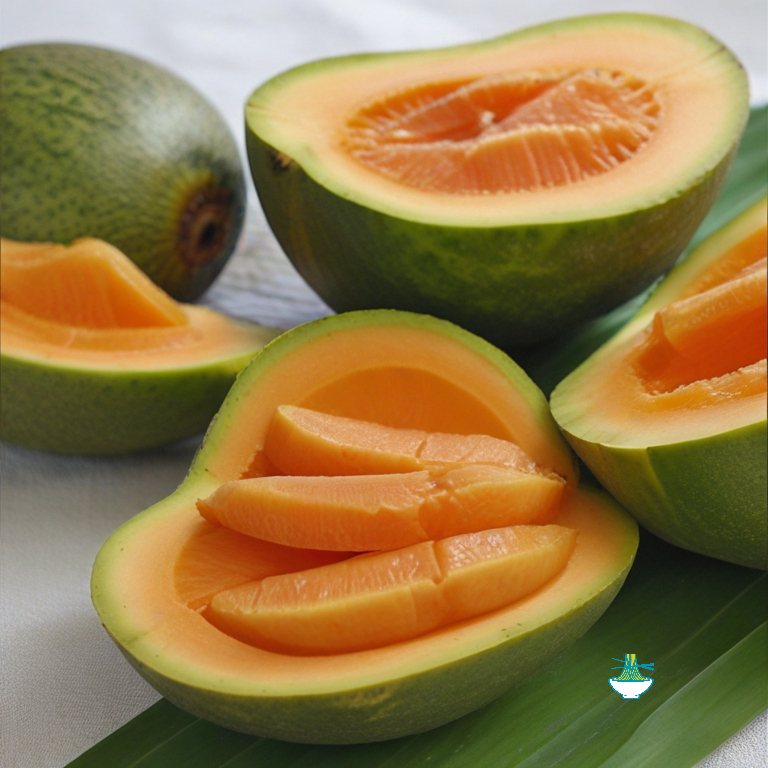Dive into the sun-kissed paradise of Federated States of Micronesia through its signature fruit, the papaya. Renowned for its vibrant flavor and nutritional richness, the papaya holds a special place in Micronesian culture and cuisine. Join us on a journey to discover the allure of this tropical delight, from its origins in lush Micronesian landscapes to its role in traditional dishes and modern culinary innovations. Delve into the world of Federated States of Micronesia's papaya, where each bite is a taste of pure tropical bliss.
Ingredients:
- 1 ripe papaya, peeled, seeded, and diced
- 1 cucumber, peeled and diced
- 1 tomato, diced
- 1 small red onion, thinly sliced
- 1/4 cup chopped cilantro
- Juice of 2 limes
- Salt and pepper to taste
- Optional: chopped chili pepper for heat (adjust according to preference)

Instructions:
1- In a large mixing bowl, combine the diced papaya, cucumber, tomato, red onion, and chopped cilantro.
2- Squeeze the lime juice over the salad and toss gently to coat all the ingredients.
3- Season the salad with salt and pepper to taste. If you like some heat, add chopped chili pepper according to your preference.
4- Allow the flavors to meld together by refrigerating the salad for at least 30 minutes before serving.
5- Serve chilled as a refreshing side dish or accompaniment to grilled fish or seafood.
6- Enjoy the vibrant flavors of this Micronesian papaya salad, bursting with tropical freshness!
Note: Feel free to customize this recipe with additional ingredients such as shredded coconut, mango, or pineapple for added sweetness and complexity. Adjust seasoning and lime juice according to taste preferences.
Nutritional Values:
Ripe papaya (1 cup, diced):
- Calories: 67
- Carbohydrates: 17g
- Fiber: 3g
- Protein: 1g
- Fat: 0.3g
- Vitamin C: 87mg (145% DV)
- Vitamin A: 1442 IU (29% DV)
- Potassium: 358mg (10% DV)
benefits
- Rich in Vitamin C, which supports immune function and collagen production.
- High in Vitamin A, important for vision health and skin maintenance.
- Good source of potassium, essential for heart health and fluid balance.
Cucumber (1 cup, diced):
- Calories: 16
- Carbohydrates: 3.8g
- Fiber: 0.6g
- Protein: 0.8g
- Fat: 0.2g
- Vitamin C: 2.8mg (5% DV)
- Vitamin K: 10.6mcg (13% DV)
- Potassium: 152mg (4% DV)
benefits
- Hydrating due to its high water content.
- Contains Vitamin K, important for bone health and blood clotting.
- Low in calories and a good source of dietary fiber.
Tomato (1 medium, diced):
- Calories: 22
- Carbohydrates: 4.8g
- Fiber: 1.5g
- Protein: 1.1g
- Fat: 0.2g
- Vitamin C: 9.4mg (16% DV)
- Vitamin A: 1025 IU (21% DV)
- Potassium: 292mg (8% DV)
benefits
- Excellent source of Vitamin C, an antioxidant that helps protect cells from damage.
- Contains Vitamin A, which supports eye health and immune function.
- Rich in potassium, beneficial for blood pressure regulation.
Red onion (1 small):
- Calories: 28
- Carbohydrates: 6.5g
- Fiber: 1.2g
- Protein: 0.7g
- Fat: 0.1g
- Vitamin C: 5.3mg (9% DV)
- Vitamin B6: 0.1mg (6% DV)
- Potassium: 102mg (3% DV)
benefits
- Contains quercetin, a powerful antioxidant with anti-inflammatory properties.
- Good source of Vitamin C, supporting immune function and skin health.
- Provides some Vitamin B6, important for metabolism and nervous system function.
Cilantro (1/4 cup, chopped):
- Calories: 1
- Carbohydrates: 0.1g
- Fiber: 0g
- Protein: 0.1g
- Fat: 0g
- Vitamin A: 16.3 IU (0% DV)
- Vitamin C: 0.5mg (1% DV)
- Vitamin K: 5.6mcg (7% DV)
benefits
- Contains antioxidants and may help to lower inflammation.
- Provides small amounts of Vitamin A and Vitamin C.
- Adds flavor without significantly increasing calorie or fat content.
Lime juice (Juice of 2 limes):
- Calories: 16
- Carbohydrates: 5.3g
- Fiber: 0.2g
- Protein: 0.5g
- Fat: 0.1g
- Vitamin C: 29.1mg (49% DV)
benefits
- High in Vitamin C, supporting immune function and skin health.
- Adds acidity and flavor to dishes without additional calories.
- Contains antioxidants that may help protect against cell damage.
These values are approximate and can vary based on factors such as the size and ripeness of the ingredients. Additionally, the salad is low in calories and fat, making it a healthy and refreshing option.


Comments